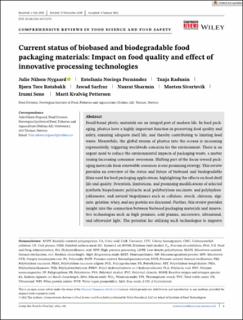Current status of biobased and biodegradable foodpackaging materials: Impact on food quality and effect ofinnovative processing technologies
| dc.contributor.author | Nilsen-Nygaard, Julie | |
| dc.contributor.author | Noriega Fernández, Estefanía | |
| dc.contributor.author | Radusin, Tanja | |
| dc.contributor.author | Rotabakk, Bjørn Tore | |
| dc.contributor.author | Sarfraz, Jawad | |
| dc.contributor.author | Sharmin, Nusrat | |
| dc.contributor.author | Sivertsvik, Morten | |
| dc.contributor.author | Sone, Izumi | |
| dc.contributor.author | Pettersen, Marit Kvalvåg | |
| dc.date.accessioned | 2021-02-19T11:17:54Z | |
| dc.date.available | 2021-02-19T11:17:54Z | |
| dc.date.created | 2021-02-16T12:51:27Z | |
| dc.date.issued | 2021 | |
| dc.identifier.citation | Comprehensive Reviews in Food Science and Food Safety. 2021, . | |
| dc.identifier.issn | 1541-4337 | |
| dc.identifier.uri | https://hdl.handle.net/11250/2729173 | |
| dc.description.abstract | Fossil-based plastic materials are an integral part of modern life. In food packaging, plastics have a highly important function in preserving food quality and safety, ensuring adequate shelf life, and thereby contributing to limiting food waste. Meanwhile, the global stream of plastics into the oceans is increasing exponentially, triggering worldwide concerns for the environment. There is an urgent need to reduce the environmental impacts of packaging waste, a matter raising increasing consumer awareness. Shifting part of the focus toward packaging materials from renewable resources is one promising strategy. This review provides an overview of the status and future of biobased and biodegradable films used for food packaging applications, highlighting the effects on food shelf life and quality. Potentials, limitations, and promising modifications of selected synthetic biopolymers; polylactic acid, polybutylene succinate, and polyhydroxyalkanoate; and natural biopolymers such as cellulose, starch, chitosan, alginate, gelatine, whey, and soy protein are discussed. Further, this review provides insight into the connection between biobased packaging materials and innovative technologies such as high pressure, cold plasma, microwave, ultrasound, and ultraviolet light. The potential for utilizing such technologies to improve | |
| dc.language.iso | eng | |
| dc.subject | Processing technologies | |
| dc.subject | Processing technologies | |
| dc.subject | Shelf life | |
| dc.subject | Shelf life | |
| dc.subject | Biobased and biodegradable materials | |
| dc.subject | Biobased and biodegradable materials | |
| dc.subject | Matkvalitet | |
| dc.subject | Foodquality | |
| dc.subject | Matemballasje | |
| dc.subject | Food packaging materials | |
| dc.title | Current status of biobased and biodegradable foodpackaging materials: Impact on food quality and effect ofinnovative processing technologies | |
| dc.type | Peer reviewed | |
| dc.type | Journal article | |
| dc.description.version | publishedVersion | |
| dc.source.pagenumber | 48 | |
| dc.source.journal | Comprehensive Reviews in Food Science and Food Safety | |
| dc.identifier.doi | 10.1111/1541-4337.12715 | |
| dc.identifier.cristin | 1890356 | |
| dc.relation.project | Norges forskningsråd: 262306 | |
| dc.relation.project | Nofima AS: 12596 | |
| dc.relation.project | Nofima AS: 201704 | |
| cristin.ispublished | true | |
| cristin.fulltext | original | |
| cristin.qualitycode | 1 |
Tilhørende fil(er)
Denne innførselen finnes i følgende samling(er)
-
Artikler / Articles [1456]
-
Publikasjoner fra CRIStin [2533]
